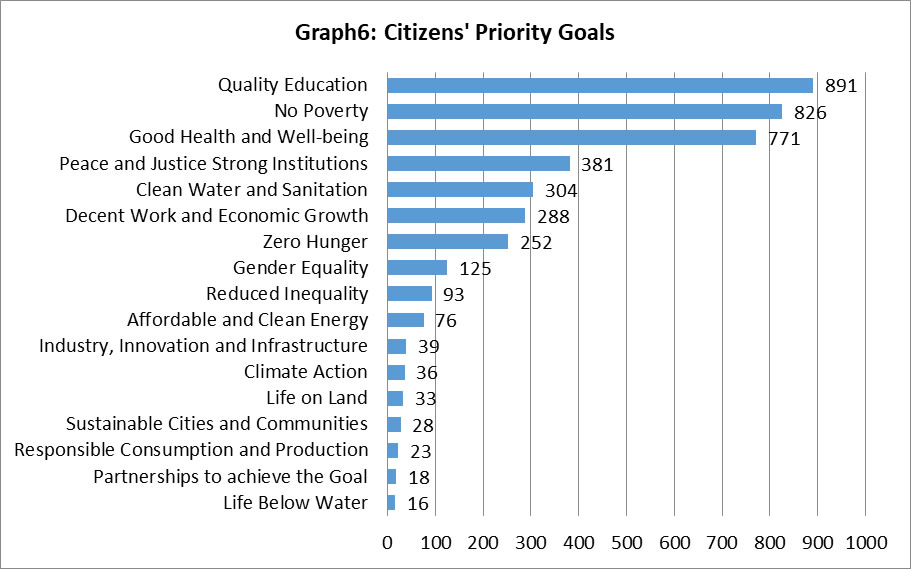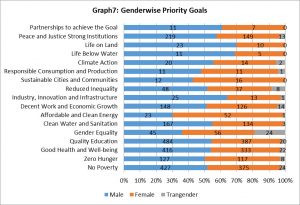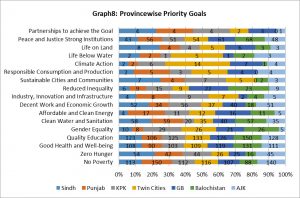The below matrix shows that SDG4 (quality education) is the top most priority of most of the provinces and regions except Azad Jammu & Kashmir as well as Punjab have opted SDG1(no poverty) as their top most priority. However, overall SDG1(no poverty), SDG3(good health & well being) and SDG4(quality education) remained the top three priorities with change of sequences among regions and provinces. This is pertinent to mention that SDG5 (gender equality), SDG 10(reduce inequalities), SDG13(climate change) and SDG16(peace, justice and strong institutions) which are normally considered as most chronic issues in Pakistan were not even given importance the citizens’ at large. There may be following critical reasons behind these results;
a) most of the people in Pakistan are striving for their basic needs including livelihood, health and education therefore they are not thinking beyond their immediate requirements.
b) most of the people have misconceptions about gender equality, economic equality and their political roles considering the influence of religion and state institutions
c) general public in Pakistan is not aware about the impacts of climate changes and importance of adaptations.
| Priority 1 | Priority 2 | Priority 3 | Priority 4 | Priority 5 | Priority 6 | Priority 7 | Priority 8 | Priority 9 | Priority 10 | |
| National | SDG 4 | SDG 1 | SDG 3 | SDG 16 | SDG 6 | SDG 8 | SDG 2 | SDG 5 | SDG 10 | SDG 7 |
| A J & K | SDG 1 | SDG 4 | SDG 3 | SDG 8 | SDG 16 | SDG 2 | SDG 6 | SDG 10 | SDG 5 | SDG7 |
| Balochistan | SDG 4 | SDG 3 | SDG 1 | SDG 16 | SDG 6 | SDG 5 | SDG 10 | SDG 2 | SDG 7 | SDG 9 |
| Gilgit Baltistan | SDG 4 | SDG 3 | SDG 1 | SDG 16 | SDG 8 | SDG 2 | SDG 10 | SDG 5 | SDG 7 | SDG 13 |
| Khyber Pakhtunkhwa | SDG 4 | SDG 1 | SDG 3 | SDG 8 | SDG 16 | SDG 5 | SDG 6 | SDG 10 | SDG 7 | SDG 9 |
| Punjab | SDG 1 | SDG 4 | SDG 3 | SDG 6 | SDG 16 | SDG 2 | SDG 8 | SDG 7 | SDG 10 | SDG 5 |
| Sindh | SDG 4 | SDG 1 | SDG 3 | SDG 6 | SDG 2 | SDG 8 | SDG 16 | SDG 5 | SDG 10 | SDG 7 |
| Twin Cities (Islamabad & Rawalpindi) | SDG 4 | SDG 1 | SDG 3 | SDG 16 | SDG 8 | SDG 6 | SDG 5 | SDG 2 | SDG 13 | SDG 7 |
Federal, provincial and regional governments have yet to prepare their priority frameworks therefore, the priority SDGs selected the citizens’ as mentioned in the Table(a) cannot be compared with those of official priority SDGs. However, if we see the National SDG Framework approved the last government in March 2018 it shows no big difference in the priorities of government as compared to those of citizens. Government placed SDG 2, SDG 3, SDG 4 SDG 6, SDG 7, SDG 8, SDG 9, SDG 12, SDG 16 and SDG 17 with certain selected priority targets in the Category-I with the understanding that desirable outcome would be achieved in shorter period through immediate policy level reforms and interventions. If we compare it with the top ten citizens’ priority SDGs as mentioned in the Table(a), this would be disappointing to learn that government has over looked the need and importance of SDG 1 (no poverty), SDG 5 (gender equality), SDG 10 (reduce inequalities) and SDG 13 (climate action). SDG 1, SDG 5 and SDG 10 are placed in Category-II that require relatively longer timeframe and consistent policy support. SDG 13 is placed in Category-III that require major institutional reforms to achieve desired outcome.
According to the UNDP’s Multidimensional Poverty Index Report 2019 Pakistan is a country with severe multidimensional poverty as its intensity of deprivation score is 51.7%. Furthermore, the same report mentions that Pakistan’s inequality among the poor value is 0.023, which is highest in the south Asian region. Further to this, according to Global Gender Gap Report 2020 Pakistan is ranked at the third-bottom (151st out of 153 countries) across the world with gender parity score 0.564. The situation demands the immediate attentions towards SDG 1, SDG 5 and SDG 10 as resulted in the SDGs Citizens’ Priority Index.
This is also pertinent to mention here that Pakistan falls in the first 10 most climate hit countries in the world. Deadly earthquake in 2005 and devastating floods in 2010, 2012 and 2014 had also warned subsequent governments to invest on climate changes for better adaptations as well as for reducing climate change impacts on life and livelihood of people. Now the same has been demanded the citizens however government and its institutions are not serious in giving immediate attentions to SDGs 13.
In nutshell, the government’s National Priority Framework on SDGs is once again based on tactical move towards the achievement of SDGs for the purpose of reporting to global community and not based on the priority needs of the people of Pakistan.
|
Graph 7, depicts top three priority SDGs goals selected male, female and transgender respondents. Out of 724 male respondents 484 (67%) opted to select SDGs4 (quality education) as the top most priority whereas 427 male respondents (59%) opted to select SDG1(no poverty) as the second most top priority goal. 416 male respondents (57%) considered SDG3(good health & well being) as the third most important goal. Out of 610 female respondents 387 (63%)considered SDG4(quality education) as top priority 375 (61%) selected SDG1(no poverty) as second top most priority and 333 (54%) female respondents opted for SDG3(good health & well being) as third top most priority followed SDG16(peace, justice & strong institutions), SDG6(clean water & sanitation), SDG8(decent work & economic growth) and SDG 2(zero hunger). Out of 66 transgender people 24(36%) considered SDG5(gender equality) and SDG4(quality education) as the top most priority goals. Whereas 22(33%) transgender people opted for SDG3(good health & well being) as second top most priority goal. 20(30%) transgender people gave third priority to SDG4(quality education) followed SDG8(decent work & economic growth) and SDG16(peace, justice & strong institutions). |



